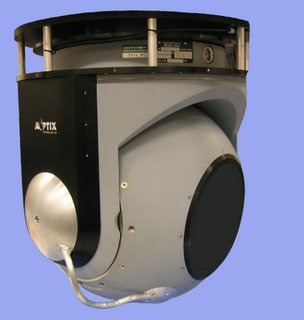


|

|
|
|
Home |
The Mil & Aero Blog
 Posted by John Keller ORLANDO, Fla. -- I think it's obvious that laser crosslinks represent the future of military tactical networking on land, at sea, and in the air. Laser communications are fast, difficult to detect or intercept, and represent bandwidth broad enough to handle the demands of image-intensive real-time intelligence, surveillance, and reconnaissance. Laser communications, moreover, are not limited by the factors that burden RF-based wireless networking: limited bandwidth, dwindling spectrum, and relatively easy detection. RF tactical networking also must conceal itself from would-be jammers and eavesdroppers by technically demanding means of encryption, frequency hopping, and spread-spectrum transmissions. Let's face it, however, laser communications are difficult. This technology can be limited by smoke, dust, and clouds. Perhaps more importantly, its laser beams can be attenuated and distorted by atmospheric disturbances. Aircraft have been particularly difficult because their motion makes it difficult to keep a laser beam focused and on target. Many of these problems may be on the way to solution, however, with a company called AOptix Technologies Inc. in Campbell, Calif., which has come up with an adaptive optics system called R3.1 Skyball that can compensate for atmospheric distortion and aircraft motion such that high-speed laser networking on land, at sea, and in the air suddenly becomes feasible. AOptix is demonstrating the Skyball system this week at the SPIE Defense & Security conference and trade show in Orlando, Fla. Short range, AOptix experts have tested the system sending data at 800 gigabits per second. At long range, they have demonstrated the system at distances as far as 93 miles (150 kilometers) at 40 gigabits per second. Think of it; 40 gigabits per second is faster than many of your laptop computers typically can access the Internet wirelessly. What would 800 gigabits per second networking aircraft, ships, and ground stations bring to the table? The U.S. military is pursuing a concept called network-centric warfare. Well, this could be one of the keys. AOptix officials point out the possibility of moving massive amounts of intelligence, reconnaissance, and surveillance data nearly in real time from platforms like manned and unmanned aircraft, as well as satellites, to tactical command centers. These command centers, in turn, could quickly process this data, synthesize it into valuable information, and send it back out in real time via laser links to soldiers, sailors, and airmen on the front lines. Simply put, this could put us well on the way to the ultimate goal of getting the warfighter the information he needs, just when he wants it. Terrestrial laser communications links. Sounds like the future to me. << Home |
Welcome to the lighter side of Military & Aerospace Electronics. This is where our staff recount tales of the strange, the weird, and the otherwise offbeat. We could put news here, but we have the rest of our Website for that. Enjoy our scribblings, and feel free to add your own opinions. You might also get to know us in the process. Proceed at your own risk. 
John Keller is editor-in-chief of Military & Aerospace Electronics magazine, which provides extensive coverage and analysis of enabling electronic and optoelectronic technologies in military, space, and commercial aviation applications. A member of the Military & Aerospace Electronics staff since the magazine's founding in 1989, Mr. Keller took over as chief editor in 1995.  Courtney E. Howard is senior editor of Military & Aerospace Electronics magazine. She is responsible for writing news stories and feature articles for the print publication, as well as composing daily news for the magazine's Website and assembling the weekly electronic newsletter. Her features have appeared in such high-tech trade publications as Military & Aerospace Electronics, Computer Graphics World, Electronic Publishing, Small Times, and The Audio Amateur.
Courtney E. Howard is senior editor of Military & Aerospace Electronics magazine. She is responsible for writing news stories and feature articles for the print publication, as well as composing daily news for the magazine's Website and assembling the weekly electronic newsletter. Her features have appeared in such high-tech trade publications as Military & Aerospace Electronics, Computer Graphics World, Electronic Publishing, Small Times, and The Audio Amateur.
 John McHale is executive editor of Military & Aerospace Electronics magazine, where he has been covering the defense Industry for more than dozen years. During that time he also led PennWell's launches of magazines and shows on homeland security and a defense publication and website in Europe. Mr. McHale has served as chairman of the Military & Aerospace Electronics Forum and its Advisory Council since 2004. He lives in Boston with his golf clubs.
John McHale is executive editor of Military & Aerospace Electronics magazine, where he has been covering the defense Industry for more than dozen years. During that time he also led PennWell's launches of magazines and shows on homeland security and a defense publication and website in Europe. Mr. McHale has served as chairman of the Military & Aerospace Electronics Forum and its Advisory Council since 2004. He lives in Boston with his golf clubs.
Previous Posts
Archives
|
|||||
Internet gems
THE MAE WEBSITE AUTHORS ARE SOLELY RESPONSIBLE FOR THE CONTENT AND ACCURACY OF THEIR BLOGS, INCLUDING ANY OPINIONS THEY EXPRESS, AND PENNWELL IS NOT RESPONSIBLE FOR AND HEREBY DISCLAIMS ANY AND ALL LIABILITY FOR THE CONTENT, ITS ACCURACY, AND OPINIONS THAT MAY BE CONTAINED HEREIN. THE CONTENT ON THE MAE WEBSITE MAY BE DATED AND PENNWELL IS UNDER NO OBLIGATION TO PROVIDE UPDATES TO THE INFORMATION INCLUDED HEREIN.
|
||||||
|
|
Home | About Us | Contact Us | Corporate Website | Privacy Policy | Courage and Valor Foundation | Site Map
Also Visit: Laser Focus World | Vision Systems Design | Industrial Laser Solutions Copyright © 2007: PennWell Corporation, Tulsa, OK; All Rights Reserved. | Terms & Conditions | Webmaster |
Wednesday, March 19, 2008 8:47:00 AM EDT